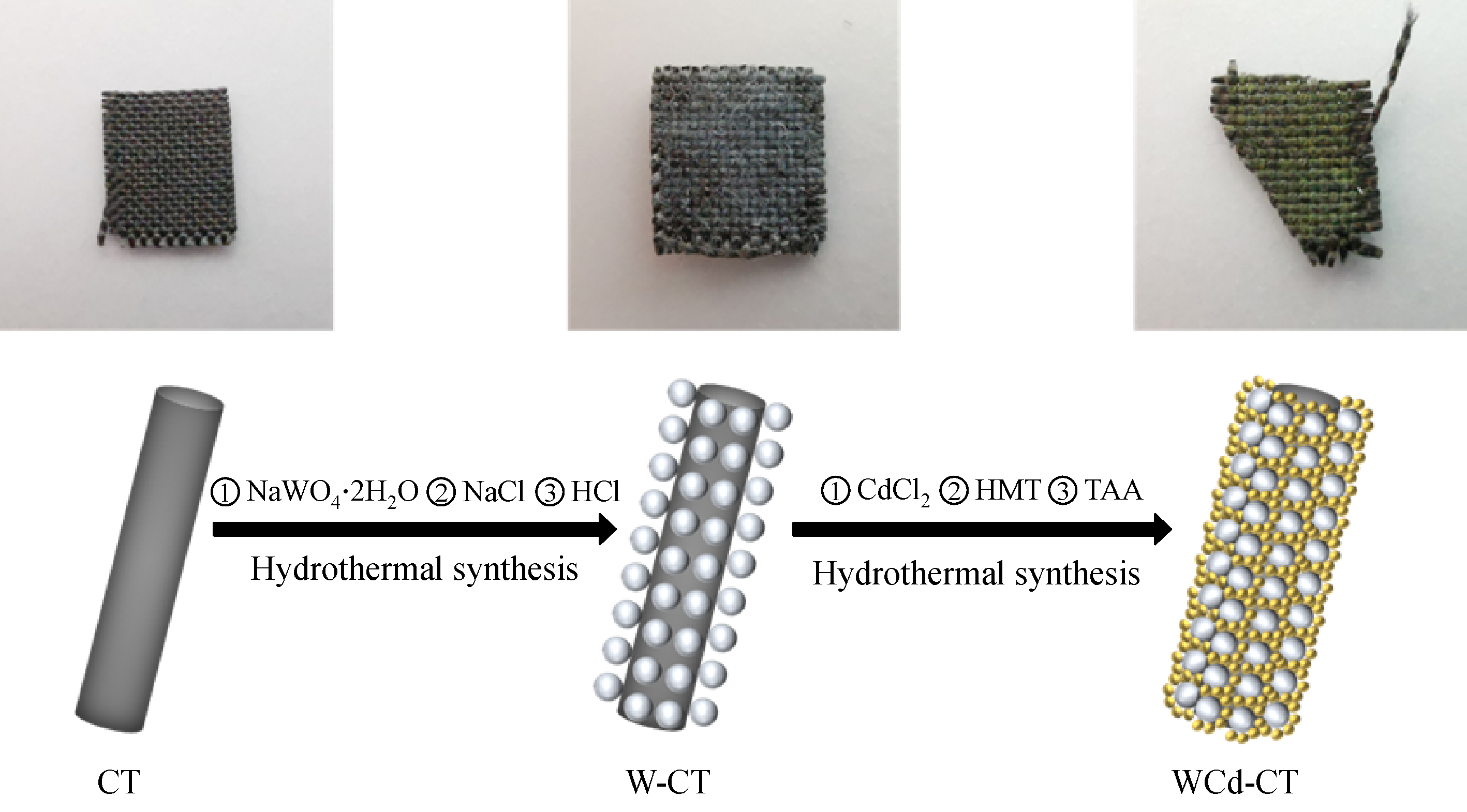

Z-scheme CdS/WO3 on a carbon cloth enabling effective hydrogen evolution
Received date: 21 Feb 2021
Accepted date: 31 May 2021
Published date: 15 Sep 2021
Copyright
Photocatalytic water splitting for hydrogen (H2) generation is a potential strategy to solve the problem of energy crisis and environmental deterioration. However, powder-like photocatalysts are difficult to recycle, and the agglomeration of particles would affect the photocatalytic activity. Herein, a direct Z-scheme CdS/WO3 composite photocatalyst was fabricated based on carbon cloth through a two-step process. With the support of carbon cloth, photocatalysts tend to grow uniformly for further applications. The experimental results showed that the H2 yield of adding one piece of CdS/WO3 composite material was 17.28 μmol/h, which was 5.5 times as compared to that of pure CdS-loaded carbon cloth material. A cycle experiment was conducted to verify the stability of the as-prepared material and the result demonstrated that the H2 generation performance of CdS/WO3 decreased slightly after 3 cycles. This work provides new ideas for the development of recyclable photocatalysts and has a positive significance for practical applications.

Key words: photocatalysis; CdS/WO3; carbon cloth; Z-scheme; hydrogen evolution
Zehong XU , Qiaohong ZHU , Xinguo XI , Mingyang XING , Jinlong ZHANG . Z-scheme CdS/WO3 on a carbon cloth enabling effective hydrogen evolution[J]. Frontiers in Energy, 2021 , 15(3) : 678 -686 . DOI: 10.1007/s11708-021-0768-6
| 1 |
Hayat A, Chen Z, Luo Z,
|
| 2 |
Xu J, Mao M, Yu H. Functionalization of sheet structure Co-Mo-S with Ni(OH)2 for efficient photocatalytic hydrogen evolution. Research on Chemical Intermediates, 2020, 46(3): 1823–1840
|
| 3 |
Turner J A. Sustainable hydrogen production. Science, 2004, 305(5686): 972–974
|
| 4 |
Fujishima A, Honda K. Electrochemical photolysis of water at a semiconductor electrode. Nature, 1972, 238(5358): 37–38
|
| 5 |
Tang J, Gao B, Pan J,
|
| 6 |
Kumaravel V, Mathew S, Bartlett J,
|
| 7 |
Sampaio M J, Oliveira J W L, Sombrio C I L,
|
| 8 |
Zhu C, Liu C, Fu Y,
|
| 9 |
Shang L, Tong B, Yu H,
|
| 10 |
Hao X, Wang Y, Zhou J,
|
| 11 |
Zhao J, Zhang Z, Chen X,
|
| 12 |
Prasad C, Tang H, Liu Q,
|
| 13 |
Kim D, Yong K. Boron doping induced charge transfer switching of a C3N4/ZnO photocatalyst from Z-scheme to type II to enhance photocatalytic hydrogen production. Applied Catalysis B: Environmental, 2021, 282: 119538
|
| 14 |
Yuan Y J, Chen D, Yu Z T,
|
| 15 |
Wei R, Huang Z, Gu G,
|
| 16 |
Wang D, Zeng H, Xiong X,
|
| 17 |
Villa K, Murcia-López S, Andreu T,
|
| 18 |
Jin J, Yu J, Guo D,
|
| 19 |
Maeda K. Z-scheme water splitting using two different semiconductor photocatalysts. ACS Catalysis, 2013, 3(7): 1486–1503
|
| 20 |
Xu Q, Zhang L, Yu J,
|
| 21 |
Niu X, Bai X, Zhou Z,
|
| 22 |
Liu Q, Shen J, Yang X,
|
| 23 |
Zhou F, Fan J, Xu Q,
|
| 24 |
Wang S, Zhu B, Liu M,
|
| 25 |
Qiu B, Zhu Q, Du M,
|
| 26 |
Cui H, Li B, Li Z,
|
| 27 |
Balta Z, Bilgin Simsek E, Berek D. Solvothermal synthesis of WO3/TiO2/carbon fiber composite photocatalysts for enhanced performance under sunlight illumination. Photochemistry and Photobiology, 2019, 95(6): 1331–1338
|
| 28 |
Li F, Chen L, Knowles G P,
|
| 29 |
Vaiano V, Iervolino G. Facile method to immobilize ZnO particles on glass spheres for the photocatalytic treatment of tannery wastewater. Journal of Colloid and Interface Science, 2018, 518: 192–199
|
| 30 |
Huang Y, Guo Z, Liu H,
|
| 31 |
Wang J, Khoo E, Lee P S,
|
| 32 |
Kim C H, Kim B H, Yang K S. TiO2 nanoparticles loaded on graphene/carbon composite nanofibers by electrospinning for increased photocatalysis. Carbon, 2012, 50(7): 2472–2481
|
| 33 |
Shi J, Cui H, Chen J,
|
| 34 |
Peng Q, Li Y, He X,
|
| 35 |
Gu L, Wang J, Cheng H,
|
| 36 |
Hu T, Li P, Zhang J,
|
| 37 |
Zhang L J, Li S, Liu B K,
|
/
| 〈 |
|
〉 |